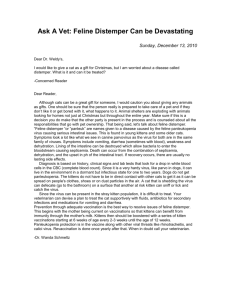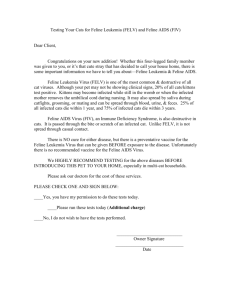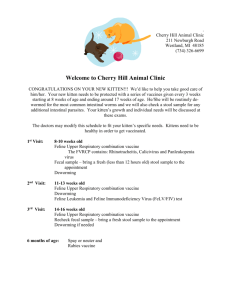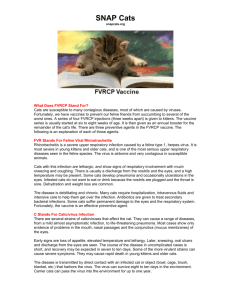Feline Panleukopenia: Guide to Symptoms, Treatment & Prevention
advertisement
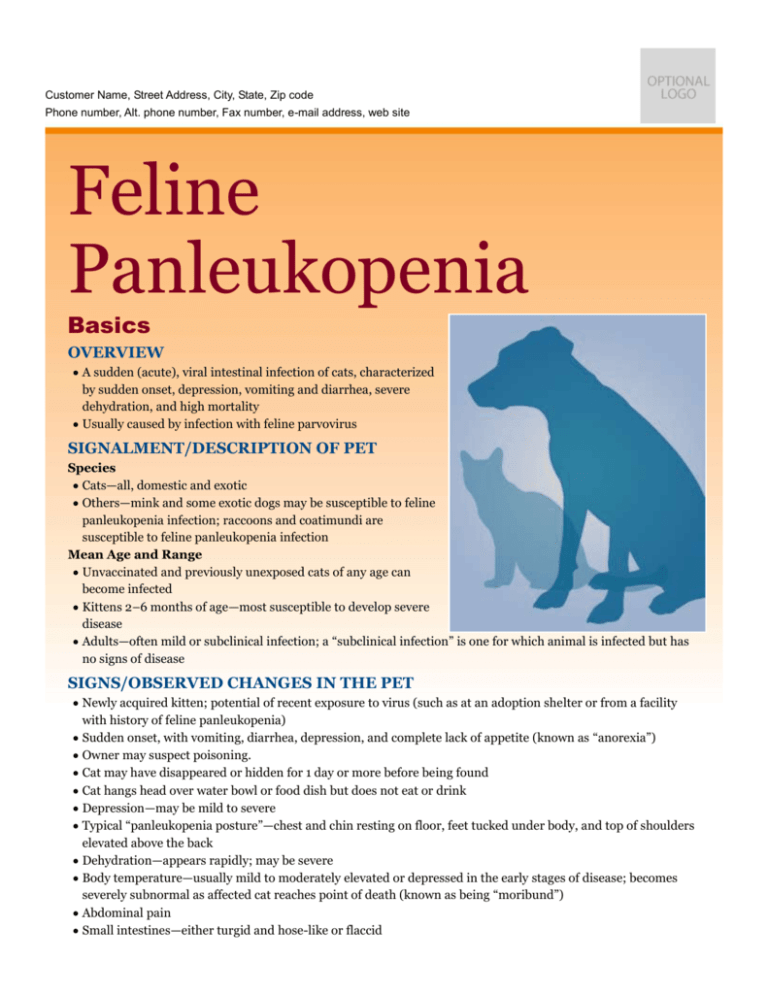
Customer Name, Street Address, City, State, Zip code Phone number, Alt. phone number, Fax number, e-mail address, web site Feline Panleukopenia Basics OVERVIEW • A sudden (acute), viral intestinal infection of cats, characterized by sudden onset, depression, vomiting and diarrhea, severe dehydration, and high mortality • Usually caused by infection with feline parvovirus SIGNALMENT/DESCRIPTION OF PET Species • Cats—all, domestic and exotic • Others—mink and some exotic dogs may be susceptible to feline panleukopenia infection; raccoons and coatimundi are susceptible to feline panleukopenia infection Mean Age and Range • Unvaccinated and previously unexposed cats of any age can become infected • Kittens 2–6 months of age—most susceptible to develop severe disease • Adults—often mild or subclinical infection; a “subclinical infection” is one for which animal is infected but has no signs of disease SIGNS/OBSERVED CHANGES IN THE PET • Newly acquired kitten; potential of recent exposure to virus (such as at an adoption shelter or from a facility with history of feline panleukopenia) • Sudden onset, with vomiting, diarrhea, depression, and complete lack of appetite (known as “anorexia”) • Owner may suspect poisoning. • Cat may have disappeared or hidden for 1 day or more before being found • Cat hangs head over water bowl or food dish but does not eat or drink • Depression—may be mild to severe • Typical “panleukopenia posture”—chest and chin resting on floor, feet tucked under body, and top of shoulders elevated above the back • Dehydration—appears rapidly; may be severe • Body temperature—usually mild to moderately elevated or depressed in the early stages of disease; becomes severely subnormal as affected cat reaches point of death (known as being “moribund”) • Abdominal pain • Small intestines—either turgid and hose-like or flaccid • Subclinical or mild infections with few or no clinical signs common, especially in adults • Wobbly, incoordinated or “drunken” appearing gait or movement with lack of coordination of the limbs, head, and/or trunk (known as “ataxia”) from underdevelopment of the cerebellum (the part of the brain responsible for body posture and balance; condition known as “cerebellar hypoplasia”)—kittens infected with feline parvovirus while in the uterus or as newborns; signs evident at 10–14 days of age and persist for life: overreaching or overstepping (known as “hypermetria”); incoordination with a base-wide stance and an elevated “rudder” tail; alert and otherwise normal; abnormal development of the back part of the eye (retina; condition known as “retinal dysplasia”) sometimes seen CAUSES • Feline parvovirus • Canine parvovirus Types 2a, 2b, and 2c can produce feline panleukopenia in domestic and exotic cats RISK FACTORS • Unvaccinated kittens and cats—most severe infectious disease of cats • Intestinal parasites; intestinal disease-causing bacteria • Secondary or coexistent infections—such as viral upper respiratory infections • Age—kittens 2–6 months of age tend to be affected more severely Treatment HEALTH CARE • Main principles of treatment—rehydration; reestablishment of electrolyte balance; supportive care until the pet's immune system produces antiviral antibodies that neutralize the virus • Inpatient—severe cases; hydration and replacement electrolyte therapy • Outpatient—mild cases • Fluid therapy—essential in severe cases; with electrolyte replacement and intravenous nutrient support may well make the difference between survival and death • Whole blood transfusions—may be necessary if plasma protein levels drop too low or if total white blood cell (WBC) count is too low (less than 2,000 cells/dL) ACTIVITY • Keep pet indoors during the sudden (acute) disease—prevent contamination of the environment; prevent the cat from going into hiding DIET • Temporarily withhold food until the sudden (acute) inflammation of the stomach and intestines (known as “gastroenteritis”) is controlled, as directed by your pet's veterinarian Medications Medications presented in this section are intended to provide general information about possible treatment. The treatment for a particular condition may evolve as medical advances are made; therefore, the medications should not be considered as all inclusive • Broad-spectrum antibiotics—counter the presence of bacteria in the blood (known as “bacteremia”) that enter the bloodstream from the diseased intestines Follow-Up Care PATIENT MONITORING • Monitor hydration and electrolyte balance closely • Monitor complete blood count (CBC) daily or at least every 2 days until recovery PREVENTIONS AND AVOIDANCE • Contaminated environments (such as cat carriers, cages, floors, food and water dishes) should be disinfected with a 1:32 dilution of household bleach • Parvovirus is resistant to most commercial disinfectants Vaccines • Feline panleukopenia vaccines are considered to be one of the core vaccines, according to the American Association of Feline Practitioners' Guidelines; should be given to all cats • Feline panleukopenia is completely preventable by routine vaccination of kittens • Modified live virus (MLV) or inactivated virus vaccines are available; vaccines may be administered by injection or into the nose (intranasal vaccine), as directed by the manufacturer • Immunity—long duration, perhaps even for life • Kittens—vaccinate as early as 6 weeks of age; then every 3–4 weeks until 16 weeks of age; recent American Association of Feline Practitioners' vaccine guideline recommendations have changed the last in the series of kitten vaccinations to be given when the kitten is at least 16 weeks of age, instead of previous 12 weeks of age; maternally derived immunity in some kittens may not have decreased until 16 weeks of age (the presence of maternally derived immunity can interfere with the kitten's response to administered vaccinations); maternally derived immunity is the presence of antibodies from the mother cat (queen), which are passed to the kittens through the colostrum (the first milk received by nursing kittens)—the antibodies help to protect the kittens when they are very young; these antibodies gradually decrease • Boosters—1 year after the last kitten vaccination; then repeat no more frequently than every 3 years, as directed by your cat's veterinarian • Do not use MLV in pregnant cats POSSIBLE COMPLICATIONS • Long-term (chronic) inflammation of the intestines (known as “enteritis”)—fungal or other cause • Abnormal development of the fetus caused by the virus (known as “teratogenic effects”), such as underdevelopment of the cerebellum (cerebellar hypoplasia) resulting in a wobbly, “drunken” appearing gait (ataxia) for life—virus infection of fetus; also may see signs with infection of the newborn kitten • Shock and other complications—severe dehydration and electrolyte imbalance EXPECTED COURSE AND PROGNOSIS • Most cases are sudden (acute), lasting only 5–7 days • If death does not occur during the sudden (acute) disease, recovery is usually rapid and uncomplicated; it may take several weeks for the pet to regain weight and body condition • Prognosis is guarded during the sudden (acute) disease, especially if the total white blood cell count is less than 2,000 cells/dL • Recovered cats are immune against feline parvovirus (panleukopenia) infection for life Key Points • All current and future cats in the household must be vaccinated against feline parvovirus (panleukopenia) before exposure • Feline parvovirus is extremely stable against environmental factors, temperature, and most disinfectants • The virus will remain infectious on the premise for years, unless the environment can be disinfected adequately with household bleach Enter notes here Blackwell's Five-Minute Veterinary Consult: Canine and Feline, Fifth Edition, Larry P. Tilley and Francis W.K. Smith, Jr. © 2011 John Wiley & Sons, Inc.

